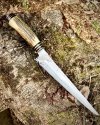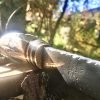Forged in Patagonia
Forged in Patagonia
- Joined
- Dec 4, 2020
- Messages
- 119
Hello all!
I'm sharing here a criollo knife I forged from 1080. Since criollos aren't that well-known, for the record they are multi-purpose blades traditionally used by gauchos here in Argentina. Good knife for everyday use, kitchen, bushcrafting, etc. The blade has a nice, strong hamon line. Patagonian deer horn handle, antique coin and leather bolster and a coin pommel featuring a dragon.
Total length: 13.1 inches, blade 8.7 inches, spine width at heel .6mm. The blade was heat-treated in water and hand sanded to 1000 grit.
This blade would be considered a "puñal guacho". This term is used rather loosely for a large class of knives so that's not being terribly specific, but it has all the main characteristics, such as the spear-pointed blade, filework on the spine and notched ricasso, minus the integral bolster (I used antique coins and leather instead).
It is the kind of criollo knife that the prominent Argentine author Abel A. Domenech, who has written several leading books on the region's knives, theorizes has a shared origin with the US Bowie knife.
If this should interest you, he writes:
"Originally blades for puñales were forged in Germany, Belgium, France and England but the exact story of the origin of the puñal remains a mystery, as does who designed its distinctive blade shape and when it actually first appeared - perhaps in the XVIII century or earlier.
The Spanish influence upon these knives is evident as soon as you compare their shape with the Belduque, Albacete and Flandes knives brought by the Spaniards to our [Argentine] lands. On the other hand, there is a Germanic influence too, as there were several types of knives of German origin which used the same blade shape long before the gaucho knife.
The so-called 'Mediterranean Dagger' (actually a single-edge knife) is a knife which was used in Spain, Italy and France during the XVII and XVIII centuries and it is commonly shown as a probable origin of the early Bowie knives and is also probably connected to certain Genovese and Corsican fixed blade knives. As a matter of fact, we know that Mississippi, Louisiana and Texas received a very strong French and Spanish influence in those days and some early Bowies elicit a strong reminiscence of the European dagger or knife." (more at http://www.vikingsword.com/ethsword/facon/criollo.html)
But back to the knife at hand.
It's comfortable for both left and right hand use and was produced by hand in a traditional forge using no heavy machinery, as are all my knives.
PAYMENT (IMPORTANT): I am ONLY selling my knives through my Etsy shop at the moment because I need all sales to go through one platform. HOWEVER, I am offering forum members a 20% discount code if contacted by private message. That should be enough to offset taxes and give you a nice discount as well. Those interested, get in touch. See the knife on Etsy (more photos) here.





I'm sharing here a criollo knife I forged from 1080. Since criollos aren't that well-known, for the record they are multi-purpose blades traditionally used by gauchos here in Argentina. Good knife for everyday use, kitchen, bushcrafting, etc. The blade has a nice, strong hamon line. Patagonian deer horn handle, antique coin and leather bolster and a coin pommel featuring a dragon.
Total length: 13.1 inches, blade 8.7 inches, spine width at heel .6mm. The blade was heat-treated in water and hand sanded to 1000 grit.
This blade would be considered a "puñal guacho". This term is used rather loosely for a large class of knives so that's not being terribly specific, but it has all the main characteristics, such as the spear-pointed blade, filework on the spine and notched ricasso, minus the integral bolster (I used antique coins and leather instead).
It is the kind of criollo knife that the prominent Argentine author Abel A. Domenech, who has written several leading books on the region's knives, theorizes has a shared origin with the US Bowie knife.
If this should interest you, he writes:
"Originally blades for puñales were forged in Germany, Belgium, France and England but the exact story of the origin of the puñal remains a mystery, as does who designed its distinctive blade shape and when it actually first appeared - perhaps in the XVIII century or earlier.
The Spanish influence upon these knives is evident as soon as you compare their shape with the Belduque, Albacete and Flandes knives brought by the Spaniards to our [Argentine] lands. On the other hand, there is a Germanic influence too, as there were several types of knives of German origin which used the same blade shape long before the gaucho knife.
The so-called 'Mediterranean Dagger' (actually a single-edge knife) is a knife which was used in Spain, Italy and France during the XVII and XVIII centuries and it is commonly shown as a probable origin of the early Bowie knives and is also probably connected to certain Genovese and Corsican fixed blade knives. As a matter of fact, we know that Mississippi, Louisiana and Texas received a very strong French and Spanish influence in those days and some early Bowies elicit a strong reminiscence of the European dagger or knife." (more at http://www.vikingsword.com/ethsword/facon/criollo.html)
But back to the knife at hand.
It's comfortable for both left and right hand use and was produced by hand in a traditional forge using no heavy machinery, as are all my knives.
PAYMENT (IMPORTANT): I am ONLY selling my knives through my Etsy shop at the moment because I need all sales to go through one platform. HOWEVER, I am offering forum members a 20% discount code if contacted by private message. That should be enough to offset taxes and give you a nice discount as well. Those interested, get in touch. See the knife on Etsy (more photos) here.





